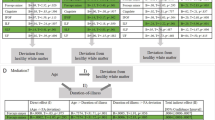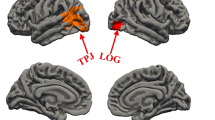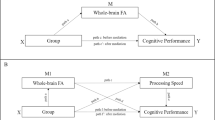Abstract
Patients with schizophrenia (SZ) display moderate reductions in brainstem volumes, including the midbrain, pons, superior cerebellar peduncle, and medulla oblongata. Here, we investigated alterations in brainstem volumes between SZ patients and healthy controls (HCs) stratified by sex. T1-weighted MRI brain scans were processed with FreeSurfer v6.0 in 156 SZ patients (61 males/95 females) and 205 HCs (133/72). Of the brainstem structures, pons volumes were significantly reduced, particularly in male SZ patients. The decreased pons volumes were correlated with lower levels of education but not duration of illness in male patients. These findings suggest that the reduction in pons volume in male patients might be occurred before or around the onset of the disorder.
Similar content being viewed by others
Introduction
The brainstem, which is located at the base of the brain, controls vital functions, such as the regulation of sleep/arousal, breathing, heart rate, and blood pressure, and subserves emotions and behavior1,2. The brainstem includes the midbrain, pons, superior cerebellar peduncle (SCP, which interconnects the pons and cerebellum), and medulla oblongata. A study found moderate reductions in these brainstem volumes in 1,044 patients with schizophrenia (SZ) compared to 2,079 healthy controls (HCs) (Cohen’s d = −0.10 for midbrain to −0.17 for pons)3. These decreased brainstem volumes may contribute to symptoms of SZ, such as impairments in sleep, autonomic functions and reflexes, although there were no significant associations between clinical symptoms and brainstem volumes in SZ patients3. Recent genome-wide association studies (GWASs) of midbrain, pons, SCP, and medulla oblongata volumes have indicated substantial heritability (h2 = 0.27 for SCP to 0.47 for midbrain and pons) and identified several genetic loci linked to brainstem volumes3. Moreover, a study found shared genetic loci between brainstem volumes and SZ3.
In addition to genetic factors and aging, there are sex differences in brainstem volumes, although these findings are not consistent across studies. Some studies have reported that males have larger brainstem volumes than females4, while others have reported no significant differences between the sexes or sex differences in the opposite direction5,6. Although the potential mechanisms underlying the sex differences are not yet fully understood, sex differences in brainstem volumes may cause sex differences in physiological function, behavior, and cognition. There is evidence for differences between males and females regarding the course and symptoms of SZ7. Males tend to develop SZ at an earlier age than females. Additionally, males may be more likely to experience a sudden onset of symptoms and negative symptoms. Considering the sex differences in the course and symptoms of SZ7, further research is needed to fully understand the relationship between brainstem volumes and SZ stratified by sex.
We hypothesized that alterations in brainstem volumes between SZ patients and HCs would be differed by sex, and the alterations in brainstem volumes would be related to clinical variables in SZ patients. In this study, we investigated alterations in four brainstem volumes between SZ patients and HCs stratified by sex.
Methods
T1-weighted MRI brain scans using a Siemens 3 T Magnetom Trio, a Tim System (Siemens, Erlangen, Germany), were collected from 156 SZ patients (61 males/95 females; mean age±SD: 42.3 ± 13.3 years) and 205 HCs (133 males/72 females; 35.7 ± 13.6 years) (Supplementary Table 1). The sample information and details regarding sample collection, inclusion and exclusion criteria, diagnostic procedures, MRI sequences, and quality controls for imaging and segmentation have been described previously8,9. Briefly, participants were recruited from the Schizophrenia Non-Affected Relative Research Project (SNARP)10. The in/outpatients were diagnosed using the DSM-5. HCs without current or past contact with psychiatric services, psychiatric medication, or family history of neuropsychiatric disease within second-degree relatives were recruited. Subjects were excluded from the analysis if they had neurological or medical conditions that could affect the central nervous system. Written informed consent was obtained from all participants. This study was approved by the Research Ethical Committees of Gifu University and Kanazawa Medical University.
Because subjects with MRI abnormalities and images with motion or metal artifacts were screened out prior to inclusion in this study, there were no gross abnormalities in any of the subjects. Next, the T1-weighted images were fully automatically processed with FreeSurfer v6.0 with the default reconstruction procedure. Using the procedure, four brainstem structure volumes, the midbrain, pons, SCP, and medulla oblongata, were obtained (Fig. 1). Segmented brainstem structure was visually inspected, and there were no subjects with obviously poor segmentation. Differences in the brainstem volumes between case and control groups were analyzed using analysis of covariance (ANCOVA) with brainstem volumes as the dependent variables; case‒control status as an independent variable; and age, age-squared, (sex), and intracranial volume (ICV) as covariates. Sex was included as a covariate in the analysis for whole participants, but sex was not included as a covariate in the analysis stratifying sex. Additionally, partial correlations between brainstem volumes and clinical variables were investigated with age, age-squared, (sex), and ICV as covariates in SZ patients. The significance level was set at a two-tailed p < 0.0125 (α = 0.05/4 brainstem structures).
Results
Male HCs had decreased brainstem volumes, except for medulla oblongata, compared with female HCs (F1,200 > 17.59, p < 0.05). Furthermore, male SZ patients had decreased midbrain (F1,151 = 15.77, p = 1.11 × 10−4), pons (F1,151 = 5.81, p = 0.017), and whole brainstem volumes (F1,151 = 7.25, p = 7.89 × 10−3) compared with female SZ patients. Of the four brainstem structures, pontine volumes in SZ patients were significantly smaller than those in HCs (Fig. 1, F1,355 = 6.62, p = 0.010). In contrast, although there were no significant differences in the other three brainstem structures between diagnostic groups (Fig. 1, p > 0.05), whole brainstem volumes consisting of all four structures were nominally decreased in SZ patients compared to HCs (F1,355 = 5.08, p = 0.025). Stratifying by sex, the differences in pons and whole brainstem volumes between diagnostic groups were prominent in male individuals (Fig. 1). Male SZ patients had decreased pons (F1,189 = 6.70, p = 0.010) and whole brainstem volumes (F1,189 = 5.50, p = 0.020) compared with male HCs, while there were no significant differences in brainstem volumes between female cases and control subjects (p > 0.05). Even after adjusting for handedness as covariates, these findings were not changed.
Consistent with a previous study3, these brainstem volumes were not significantly correlated with current clinical symptoms in all patients (Supplementary Table 2) or in patients stratified by sex (p > 0.01). Of the other clinical variables (Supplementary Table 2), lower years of education were significantly correlated with smaller pons (r = 0.24, p = 3.06 × 10−3) and whole brainstem volumes (r = 0.24, p = 3.50 × 10−3) in patients (Fig. 2), particularly male patients (p < 0.05, pons, r = 0.31; whole brainstem, r = 0.29).
Discussion
This is the first study to investigate sex differences in brainstem volumes between SZ patients and HCs. Among the brainstem structures, pons volumes were significantly reduced, particularly in male SZ patients. The decreased pons volumes were associated with lower levels of education in male patients.
Although we found a difference only in pons volumes between SZ patients and HCs among four brainstem structures, the effect sizes for the differences in brainstem volumes between the case and control groups were similar between the present and previous studies (Fig. 1). The effect sizes in this study were also moderate (d = −0.08 for midbrain to −0.25 for pons), except for SCP (d = −0.003).
The pons is involved in a variety of functions, such as the regulation of sleep/arousal, respiration, cranial nerves, and reflexes. It is currently not fully understood why pons volumes are reduced in SZ patients, particularly male SZ patients. However, some hypotheses might explain this finding. The reduction in pons volume may be due to a disruption in brain development during early life in SZ patients or a loss of neural cells or changes in the structure of the pons as a result of the disorder process. Considering the negative correlation of pons volume with education levels but not duration of illness particularly in male SZ patients and evidence that male patients have poorer premorbid adjustment than female patients7, the reduction in pons volume in male patients might be affected by changes before or around the onset of the disorder. Furthermore, as sex hormones such as estrogen can affect brain development11 and may modulate the expression of genes involved in SZ, hormonal differences may also play a role in sex differences in the brainstem volumes. The brainstem volume reductions could be related to the disorder’s genetic susceptibility3, hormonal factor and environmental factors, such as prenatal stress, infection, or substance use. The sex differences in brainstem volumes may cause sex differences in physiological function, behavior, cognition, symptom presentation and treatment response.
There are some limitations to the interpretations of our findings. Mean age and sex ratio significantly differed between SZ patients and HCs. Although we corrected for age, age-squared, sex and ICV as covariates, these confounding factors might influence our findings.
In summary, we observed decreased pons volumes particularly in male SZ patients, and the decreased pons volumes were related to low education levels. Further research is needed to understand the underlying causes and timing of the reduced pons volume in SZ.
Data availability
Our data are not publicly available because they contain information that could compromise the research participants’ privacy/consent.
References
Guyenet, P. G. The sympathetic control of blood pressure. Nat. Rev. Neurosci. 7, 335–346 (2006).
Weber, F. et al. Regulation of REM and Non-REM Sleep by Periaqueductal GABAergic Neurons. Nat. Commun. 9, 354 (2018).
Elvsåshagen, T. et al. The genetic architecture of human brainstem structures and their involvement in common brain disorders. Nat. Commun. 11, 4016 (2020).
Raz, N., Gunning-Dixon, F., Head, D., Williamson, A. & Acker, J. D. Age and sex differences in the cerebellum and the ventral pons: a prospective MR study of healthy adults. AJNR Am. J. Neuroradiol. 22, 1161–1167 (2001).
Sullivan, E. V., Rosenbloom, M., Serventi, K. L. & Pfefferbaum, A. Effects of age and sex on volumes of the thalamus, pons, and cortex. Neurobiol. Aging 25, 185–192 (2004).
Inano, S. et al. Effects of age and gender on neuroanatomical volumes. J. Magn. Reson. Imaging 37, 1072–1076 (2013).
Abel, K. M., Drake, R. & Goldstein, J. M. Sex differences in schizophrenia. Int. Rev. Psychiatry 22, 417–428 (2010).
Ohi, K. et al. Differences in subcortical brain volumes among patients with schizophrenia and bipolar disorder and healthy controls. J. Psychiatry Neurosci. 47, E77–E85 (2022).
Fujikane, D. et al. Higher polygenic risk scores for anxiety disorders are associated with reduced area in the anterior cingulate gyrus. J Affect Disord 320, 291–297 (2023).
Ohi K. et al. Cognitive performances across individuals at high genetic risk for schizophrenia, high genetic risk for bipolar disorder, and low genetic risks: a combined polygenic risk score approach. Psychol. Med. 1–10 (2022).
Dhandapani, K. M. & Brann, D. W. Protective effects of estrogen and selective estrogen receptor modulators in the brain. Biol. Reprod. 67, 1379–1385 (2002).
Acknowledgements
This work was supported by Grants-in-Aid for Scientific Research (C) (19K08081, 21K07497, 22K07614); Young Scientists (B) (16K19784) from the Japan Society for the Promotion of Science (JSPS); AMED under grant number JP21uk1024002; AMED under grant number JP22dk0307112; a grant from the Uehara Memorial Foundation; a grant from the Takeda Science Foundation; a grant from the YOKOYAMA Foundation for Clinical Pharmacology (YRY-1807); a grant from the Smoking Research Foundation; and a grant from the SENSHIN Medical Research Foundation. We would like to thank all individuals who participated in this study.
Author information
Authors and Affiliations
Contributions
K.O. supervised the entire project; collected the data; wrote the manuscript; and was critically involved in the design, analysis and interpretation of the data. S.A., H.O., N.F., H.Y., and K.O. were responsible for performing the literature review and data analyses and drafting the manuscript. D.F., K.T., A.K., Y.M., S.S., T.S., and K.O. were heavily involved in the collection of the majority of the data and intellectually contributed to data interpretation. All authors contributed to and approved the final manuscript.
Corresponding author
Ethics declarations
Competing interests
The authors declare no competing interests.
Additional information
Publisher’s note Springer Nature remains neutral with regard to jurisdictional claims in published maps and institutional affiliations.
Supplementary information
Rights and permissions
Open Access This article is licensed under a Creative Commons Attribution 4.0 International License, which permits use, sharing, adaptation, distribution and reproduction in any medium or format, as long as you give appropriate credit to the original author(s) and the source, provide a link to the Creative Commons license, and indicate if changes were made. The images or other third party material in this article are included in the article’s Creative Commons license, unless indicated otherwise in a credit line to the material. If material is not included in the article’s Creative Commons license and your intended use is not permitted by statutory regulation or exceeds the permitted use, you will need to obtain permission directly from the copyright holder. To view a copy of this license, visit http://creativecommons.org/licenses/by/4.0/.
About this article
Cite this article
Aoyama, S., Okuda, H., Furuzawa, N. et al. Sex differences in brainstem structure volumes in patients with schizophrenia. Schizophr 9, 16 (2023). https://doi.org/10.1038/s41537-023-00345-0
Received:
Accepted:
Published:
DOI: https://doi.org/10.1038/s41537-023-00345-0





